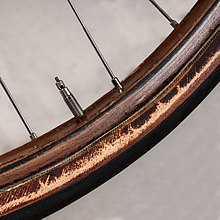Tubular tires
Tubular tires (Switzerland: Collé or Tubolare ) are a type of bicycle tire in which, unlike the commonly used clincher tires , the tire jacket is sewn to form a closed envelope, inside of which the actual rubber or latex tube is located. Tubular tires are mainly used in cycling , cross-country races , track cycling and indoor sport disciplines ( artificial cycling , cycling , cycling polo and, for example, wheelchair basketball ). Tubular tires made for the road are offered in widths of 18 to 25 mm, the mass of which is between 140 and 300 grams.
construction
The casing of a tubular tire consists of two to three layers of rubberized cotton or nylon fabric , the carcass , made grippy on the tread by a rubber pad, the protector, often reinforced by one or two strips of fabric underneath. The coat is sewn on the inside. This seam is protected with a thin, glued-on textile seam tape.
Assembly and repair
Tubular tires require rims that have a concave outer surface (the rim well) but no rim flanges . Tubular tire rims can be designed to be particularly light and stable. Until the 1950s, rims made of hickory wood were widespread; they were lighter than aluminum rims of that time, which were mostly based on a wooden core, but more complex to manufacture and only withstood moisture to a limited extent. Most recently, wooden rims were still used on track bikes and in road racing for some mountain stages. Modern rims made of carbon fiber are mostly constructed as tubular rims , which has led to a renaissance of tubular tires.
In order to keep tubular tires on the rim, they have to be glued on. In the past, a shellac-based adhesive was often used for this purpose, especially in track cycling; today, a viscous adhesive (referred to as “tire cement” in racing driver jargon) or rim tape is used for this purpose. Adhesive tape is not permitted in racing.
In the event of defects, the tire is first pulled from the rim. Often the tire cement adhering to the rim still sticks sufficiently so that the replacement tire only has to be pressed onto the rim well and inflated. If not, the rim should be completely freed from adhesive residue and dirt with emery paper and / or petrol. Then, depending on the type of adhesive, one or more layers of it are applied with a brush. Finally, the slightly inflated tubular tire is also moistened with glue at its seam seal and stretched onto the rim, if possible without twisting.
Advantages and disadvantages - alternatives
The main advantages are lower mass and lower rolling resistance . By eliminating the rim flanges required for clincher tires, significantly lighter rims are also possible, for example made of full carbon. The lower rolling resistance results mainly from the high air pressure of up to 15 bar in track cycling, which is possible due to the construction of the tubular tire.
In cyclo-cross sports, the structural advantages of tubular tires are used to achieve traction advantages on soft ground with very low air pressure (sometimes only 2.5 bar) . Another advantage is that tubular tires cannot jump off the rim if there is a loss of pressure, which reduces the risk of a fall.
The disadvantage is the considerably greater expenditure of time and money in the event of a flat tire. The tubular tire must be removed from the rim and a new one glued on. The repair of the tube is not intended, but in principle it is possible by opening the tire and sewing it back up after the tube repair, which only works with a little practice. For this reason tubular tires are almost only found in professional cycling. Another disadvantage is that the adhesive becomes soft when it is very hot (for example, when braking on long descents, especially with aluminum rims) and the tire can become detached from the rim. Then the valve can tear off or the tire jumps off the rim. This happened to professional cyclist Joseba Beloki during the ninth stage of the 2003 Tour de France when the tire jumped off the rear wheel and Beloki fell badly as a result.
Since the 1980s there have also been narrow clincher tires which, in combination with hollow-wall rims and latex tubes, offer driving characteristics similar to tubular tires.
Individual evidence
- ↑ Shellac (PDF, 31 kB), from /nati-mech.alvente.com, accessed on July 16, 2017.
- ↑ Step-by-step tubular tire assembly Continental . Continental website. Retrieved January 12, 2014.
literature
- Michael Gressmann, Franz Beck, Rüdiger Bellersheim: specialist knowledge of bicycle technology. 1st edition, Verlag Europa-Lehrmittel, Haan-Gruiten, 2006, ISBN 3-8085-2291-7
- Frank Lewerenz, Martin Kaindl, Tom Linthaler: Das Rennrad Technikbuch. 1st edition, Pietsch Verlag, Stuttgart, 2005, ISBN 3-613-50486-3
- Peter de Leuw: Choose the right bicycles, ride safely. 1st edition, Beuth Verlag GmbH, Berlin-Vienna-Zurich, 2006, ISBN 3-410-16487-1
- Jörg Urban, Jürgen Brück: Bicycle repairs, maintenance and breakdown assistance. 1st edition, Gondrom Verlag GmbH, Bindlach, 2007, ISBN 978-3-8112-2938-9


